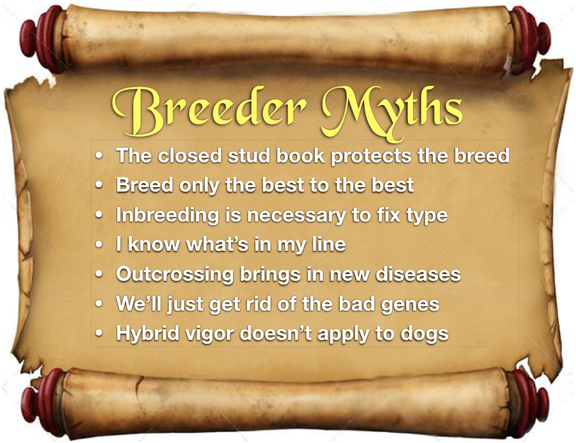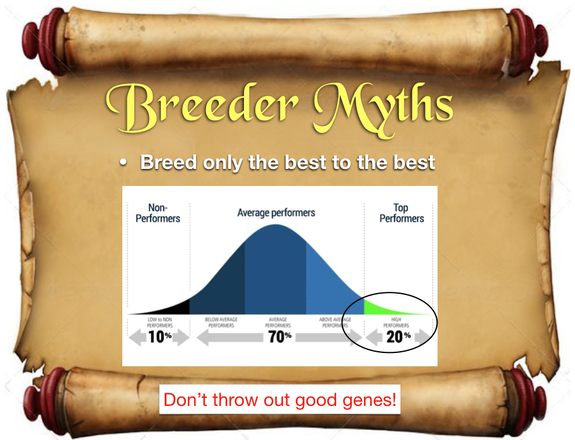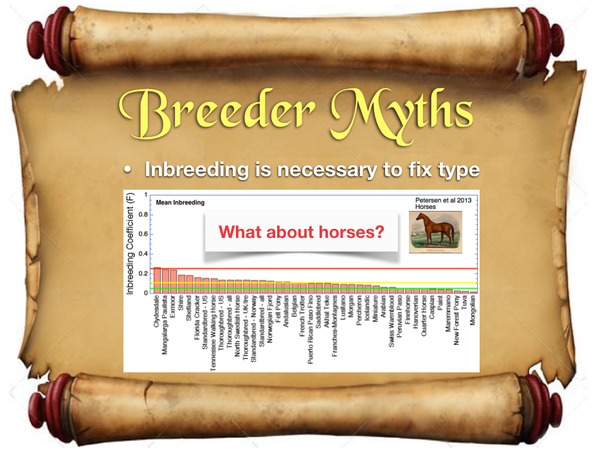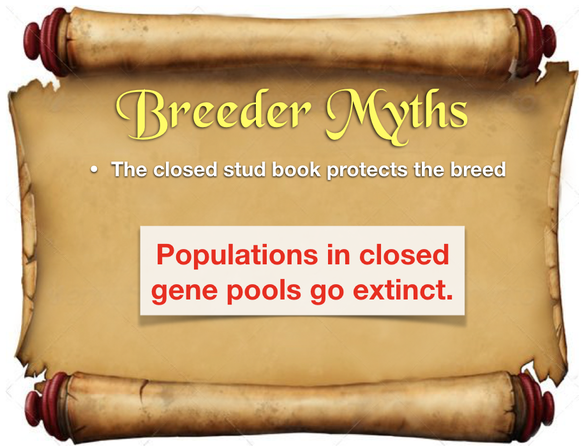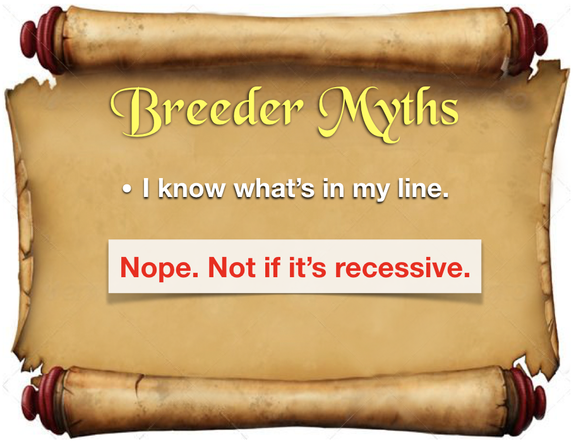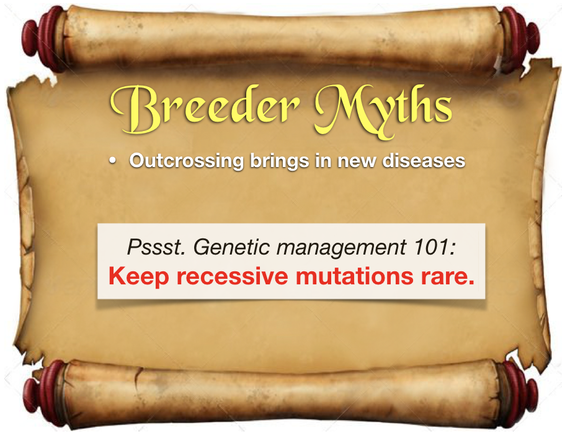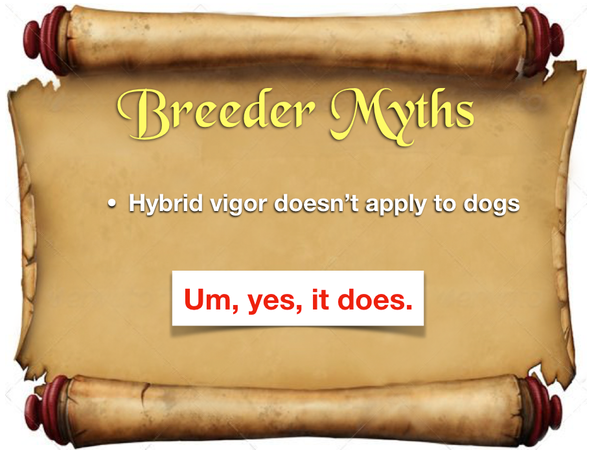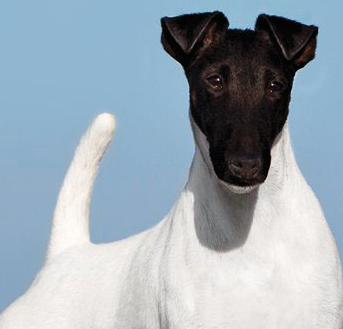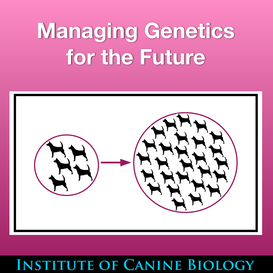This would seem obvious, but in fact there are many nuggets of old "wisdom" that get passed around and around that are, well...not true. Yet, like a fly in the kitchen, it seems no amount of swatting at these untruths will get rid of them.
You've probably heard all of these. You've probably even repeated some of them. We will examine each of them.
Breed only BEST to BEST
Look, don't breed the dogs that have no good points. But, just like in school, realize that there can be a lot of merit in "above average". In fact, if the parents of a litter were quality dogs, then the offspring inherited quality genes, but perhaps not always in the best combination. Don't toss out those valuable genes - mixed a bit differently, they could produce the next superior animal. Remember: Improvement through selection requires genetic variation. Keep a good variety of ingredients in the genetic pantry to choose from!
Selection requires genetic variation.
Inbreeding is required to fix type
The genes for breed type should be fixed in the first few generations after breed formation. Once the breed has the qualities that define it, further inbreeding simply increases homozygosity in the other "dog" genes, for things like toenails and kidneys and glucose metabolism and saliva. If there are some mutations among the thousands of genes in the dog (and of course, there are!), then inbreeding will inadvertently produce paired (homozygous) mutations for some genes. For these, whatever the normal gene is supposed to do will be broken.
Other domestic animals have clearly recognizable breeds with much lower levels of inbreeding than are typical in dogs. Most purebred dog breeds have average inbreeding in excess of 12%, and about half of the breeds are greater than 25%. In horses, most breeds are less than 12%.
Inbreeding can break things. Use it wisely.
Close the stud book to protect the breed
If the stud book is closed, genes will be lost from the gene pool through selective breeding and "genetic drift" (chance). If you start a breed with a founder gene pool, then lose genes every generation that cannot be replaced, eventually the gene pool will be depleted. You can easily test this with a bowl of M&M's on the coffee table. Grab a few when you need that chocolate fix, but don't put any back. Eventually, the bowl will be empty.
The rule of thumb here: Animals in closed gene pools go extinct.
Really? Is this always true???
In fact, no. There is a very famous herd of cattle in England, the Chillingham cattle, that has survived for centuries as a closed gene pool. They are the iconic exception.
But every other closed population has gone extinct, and yours will too. You can count on it.
Animals in closed gene pools go extinct.
I know what's in my line
You probably know about dominant alleles. They mask the expression of recessive alleles. You cannot know what recessive alleles are lurking in your gene pool as long as expression is masked by a dominant allele. You could unmask recessives using inbreeding, because as we saw above, inbreeding breaks things. Or you could avoid inbreeding, not worry about the recessive lurkers, and keep that doggy working like a well-oiled machine.
You can't know what's in your line.
Outcrossing introduces new diseases
Outcrossing does not "introduce new diseases". It introduces new alleles, some of which will probably be recessive mutations. But single mutations do not usually produce disease. In fact, as noted above, most recessive mutations are masked by dominant, normal-functioning alleles and produce no ill effects. Eliminate this problem by following a simple rule of genetic management: keep recessive mutations rare. So no popular sires!
And remember from above: Inbreeding breaks things.
Keep recessive mutations rare.
Hybrid vigor doesn't apply to dogs
Hybird vigor results when you "undo" inbreeding by mating two animals that are relatively unrelated. Inbreeding applies to dogs. So hybrid vigor applies to dogs.
No, it hybrid vigor not require different species. In fact, most interspecific hybrids are infertile and not terribly vigorous.
Nothing will make you look dumber than declaring that hybrid vigor doesn't apply to dogs.
Do yourself a favor. Look this one up. So you never forget.
Yes, hybrid vigor applies to dogs, too!
Kill the Breeder Myths, once and for all!
ICB's online courses
***************************************
Visit our Facebook Groups
ICB Institute of Canine Biology
...the latest canine news and research
ICB Breeding for the Future
...the science of animal breeding
